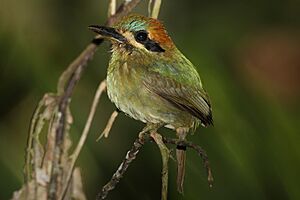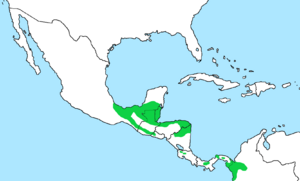Tody motmot facts for kids
Quick facts for kids Tody motmot |
|
|---|---|
 |
|
| Conservation status | |
| Scientific classification | |
| Genus: |
Hylomanes
|
| Species: |
momotula
|
 |
|
The tody motmot (Hylomanes momotula) is a small, colorful bird. It belongs to the motmot family, known for their unique beaks and tails. This bird is special because it's the only species in its group, called Hylomanes. You can find the tody motmot in several countries. These include Belize, Colombia, Costa Rica, El Salvador, Guatemala, Honduras, Mexico, Nicaragua, and Panama.
Contents
About the Tody Motmot
The tody motmot is the only bird in its specific group, or genus. Scientists have found three slightly different types of tody motmots. These are called subspecies. They are named Hylomanes momotula momotula, M. m. chiapensis, and M. m. obscurus.
What Does It Look Like?
The tody motmot is a small bird, about 16.5 to 18.0 centimeters (6.5 to 7.1 inches) long. It is the smallest of all motmots. Males usually weigh between 27 and 33 grams (0.95 to 1.16 ounces). Females are a bit lighter, weighing 25 to 30 grams (0.88 to 1.06 ounces).
This bird gets its name because it looks a lot like another bird family called todies. Todies live in the Caribbean.
The most common type of tody motmot has a green top of its head. Its neck is a reddish-brown color. The back and rump are green. It has a blue stripe above its eye. There's also a black mask across its eyes with a white stripe just below it. Its throat is white, and its chest is greenish with light streaks. The belly is white. The other two types of tody motmots look similar but are a bit darker. One of them, M. m. obscurus, also has less white on its throat.
Where It Lives
The tody motmot lives in a wide area. Its home stretches from southern Mexico all the way through Central America into Colombia. The most common type lives in many places. These include parts of Mexico, Belize, Guatemala, Honduras, and El Salvador. It also lives in Nicaragua and possibly Costa Rica.
Another type, M. m. chiapensis, is found in Chiapas, Mexico, Guatemala, and maybe El Salvador. The third type, M. m. obscurus, lives in Panama and northwestern Colombia.
This bird prefers to live in wet, evergreen forests. You can find it from sea level up to about 1,850 meters (6,070 feet) high. It especially likes to live in ravines, which are narrow valleys.
How It Behaves
What It Eats
The tody motmot eats different kinds of small creatures. Its diet includes insects, spiders, and snails. Unlike many other motmots, it has not been seen eating fruit. It catches its food in a cool way. It flies and picks prey right off plants. It also catches butterflies and dragonflies while flying in the air.
Life Cycle
Scientists don't know much about how the tody motmot raises its young. In Belize, an adult bird was seen carrying food in June. An adult and a young bird that had just learned to fly were seen in early July. A young bird was also found in Guatemala in June. In Colombia, a female bird ready to lay eggs was found in February. Another female in breeding condition was found in May. We still don't know what their nests look like.
What It Sounds Like
The tody motmot makes some interesting sounds. One call is a "resonant, far-carrying, gruff-sounding 'kwa-kwa-kwa-kwa...' or 'quah quah quah quah...'" [1]. Another sound it makes is "loud, penetrating, hollow 'whoop!' notes" [2].
Its Status
The IUCN (International Union for Conservation of Nature) has looked at the tody motmot. They have decided it is a species of "Least Concern." This means it's not currently in danger of disappearing. However, the number of tody motmots varies. In some places, it's very uncommon, while in others, it's quite common. Its home range is also spread out in different areas.


